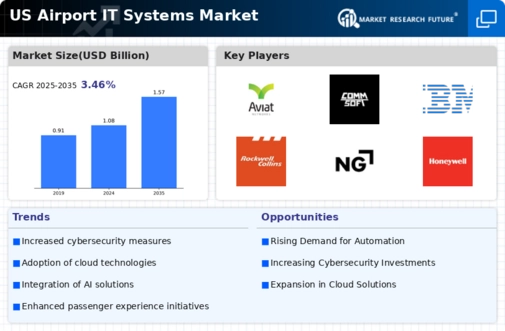Enhanced Passenger Experience
The airport it-systems market is increasingly driven by the need to enhance passenger experience. Airports are investing in advanced IT systems to streamline operations, reduce wait times, and improve overall customer satisfaction. For instance, the implementation of self-service kiosks and mobile applications allows travelers to check in, access boarding passes, and receive real-time flight updates. This shift towards a more user-friendly approach is reflected in a projected growth rate of 8% annually in the sector, as airports recognize that a positive passenger experience can lead to increased loyalty and revenue. Furthermore, the integration of biometric technologies is expected to further enhance security and efficiency, making the airport experience smoother and more enjoyable for travelers. As competition among airports intensifies, the focus on passenger-centric IT solutions is likely to remain a key driver in the airport it-systems market.
Regulatory Compliance and Security
In the airport it-systems market, regulatory compliance and security are paramount. The aviation industry is subject to stringent regulations imposed by government agencies, necessitating the adoption of advanced IT systems to ensure compliance. Airports must implement systems that facilitate secure data management, passenger screening, and baggage handling. The market is witnessing a surge in demand for IT solutions that enhance cybersecurity measures, as threats to airport operations become more sophisticated. According to recent data, investments in security-related IT systems are expected to account for approximately 30% of total spending in the airport it-systems market. This focus on compliance not only protects sensitive information but also fosters trust among passengers, thereby driving further investment in innovative IT solutions. As regulatory frameworks evolve, the need for robust IT systems will likely continue to shape the landscape of the airport it-systems market.
Operational Efficiency and Cost Reduction
Operational efficiency and cost reduction are critical drivers in the airport it-systems market. Airports are increasingly adopting IT solutions that optimize resource allocation, streamline processes, and reduce operational costs. For example, the implementation of advanced data analytics allows airports to monitor flight schedules, manage gate assignments, and allocate staff more effectively. This data-driven approach can lead to a reduction in operational costs by up to 15%, as airports minimize delays and improve turnaround times. Additionally, the integration of cloud-based systems enables real-time data sharing among various stakeholders, enhancing collaboration and decision-making. As airports strive to maintain profitability in a competitive environment, the focus on operational efficiency through innovative IT systems is likely to remain a driving force in the airport it-systems market.
Technological Advancements and Innovation
Technological advancements and innovation are pivotal in shaping the airport it-systems market. The rapid evolution of technology, including the Internet of Things (IoT), artificial intelligence (AI), and big data analytics, is transforming airport operations. These technologies enable airports to gather and analyze vast amounts of data, leading to improved decision-making and enhanced operational performance. For instance, IoT devices can monitor equipment health, while AI algorithms can predict passenger flow and optimize resource allocation. The market is projected to grow at a CAGR of 10% as airports increasingly adopt these cutting-edge technologies to stay competitive. Furthermore, the continuous innovation in IT systems is likely to drive new business models and revenue streams, making it a crucial driver in the airport it-systems market.
Sustainability Initiatives and Green Technologies
Sustainability initiatives and green technologies are becoming increasingly influential in the airport it-systems market. Airports are under pressure to reduce their environmental impact and adopt sustainable practices. This has led to the integration of IT systems that support energy management, waste reduction, and carbon footprint tracking. For example, airports are implementing smart energy management systems that optimize energy consumption and reduce costs. The market for green technologies is expected to grow by 12% as airports seek to align with global sustainability goals. Additionally, the adoption of electric ground support equipment and renewable energy sources is likely to further drive investments in IT systems that facilitate these initiatives. As environmental concerns continue to rise, the focus on sustainability within the airport it-systems market is expected to intensify.



















Leave a Comment